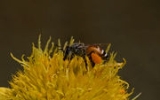
Apis florea
Encyclopedia

Species
In biology, a species is one of the basic units of biological classification and a taxonomic rank. A species is often defined as a group of organisms capable of interbreeding and producing fertile offspring. While in many cases this definition is adequate, more precise or differing measures are...
of small, wild honey bee
Honey bee
Honey bees are a subset of bees in the genus Apis, primarily distinguished by the production and storage of honey and the construction of perennial, colonial nests out of wax. Honey bees are the only extant members of the tribe Apini, all in the genus Apis...
s of southern and southeastern Asia
Asia
Asia is the world's largest and most populous continent, located primarily in the eastern and northern hemispheres. It covers 8.7% of the Earth's total surface area and with approximately 3.879 billion people, it hosts 60% of the world's current human population...
. It has a much wider distribution than its sister species
Cladistics
Cladistics is a method of classifying species of organisms into groups called clades, which consist of an ancestor organism and all its descendants . For example, birds, dinosaurs, crocodiles, and all descendants of their most recent common ancestor form a clade...
, Apis andreniformis
Apis andreniformis
Apis andreniformis or the black dwarf honey bee is a species of honey bee whose native habitat is the tropical and subtropical regions of Asia....
.
This together with A. florea is the most plesiomorphic honeybee species alive. Separating roughly about the Bartonian (some 40 mya or slightly later) from the other lineages, among themselves they do not seem to have diverged a long time before the Neogene.
These two species together comprise the subgenus Micrapis, and are the most primitive of the living species of Apis, reflected in their small colony
Colony (biology)
In biology, a colony reference to several individual organisms of the same species living closely together, usually for mutual benefit, such as stronger defense or the ability to attack bigger prey. Some insects live only in colonies...
size, and simple nest
Nest
A nest is a place of refuge to hold an animal's eggs or provide a place to live or raise offspring. They are usually made of some organic material such as twigs, grass, and leaves; or may simply be a depression in the ground, or a hole in a tree, rock or building...
construction. The exposed single combs are built on branches of shrubs and small trees. The forager
Foraging
- Definitions and significance of foraging behavior :Foraging is the act of searching for and exploiting food resources. It affects an animal's fitness because it plays an important role in an animal's ability to survive and reproduce...
bees do not perform a gravity oriented waggle dance
Waggle dance
Waggle dance is a term used in beekeeping and ethology for a particular figure-eight dance of the honey bee. By performing this dance, successful foragers can share with their hive mates information about the direction and distance to patches of flowers yielding nectar and pollen, to water...
on the vertical face of the comb to recruit nestmates as in the domesticated Apis mellifera and other species. Instead they perform the dance on the horizontal upper surface where the comb wraps around the supporting branch. The dance is a straight run pointing directly to the source of pollen
Pollen
Pollen is a fine to coarse powder containing the microgametophytes of seed plants, which produce the male gametes . Pollen grains have a hard coat that protects the sperm cells during the process of their movement from the stamens to the pistil of flowering plants or from the male cone to the...
or nectar that the forager has been visiting. In all other Apis species, the comb on which foragers dance is vertical, and the dance is not actually directed towards the food source.
Both the bees were generally identified as Apis florae, and most information still relates to this species prior to the 1990s. However, the distinctiveness of the two species Apis florea and Apis andreniformis was established unequivocally in the 1990s. Apis florea is redder and the first abdomen is always red in an old worker (younger workers are paler in colour, as is the case in giant honey bees); Apis andreniformis is in general darker and the first abdomen segment is totally black in old bees.
Ecology

Honey bee
Honey bees are a subset of bees in the genus Apis, primarily distinguished by the production and storage of honey and the construction of perennial, colonial nests out of wax. Honey bees are the only extant members of the tribe Apini, all in the genus Apis...
.
Parasites
The main parasites of both A. andreniformis and A. florea belong to genusGenus
In biology, a genus is a low-level taxonomic rank used in the biological classification of living and fossil organisms, which is an example of definition by genus and differentia...
Euvarroa. However, A. andreniformis is attacked by the species Euvarroa wongsirii, while Euvarroa sinhai preys on A. florea and colonies of Apis mellifera that are imported. The two species of Euvarroa have morphological and biological differences: while E. wongsirii has a triangular body shape and a length of 47–54 μm (micrometre
Micrometre
A micrometer , is by definition 1×10-6 of a meter .In plain English, it means one-millionth of a meter . Its unit symbol in the International System of Units is μm...
s), E. sinhai has a more circular shape and a length of 39–40 μm.

